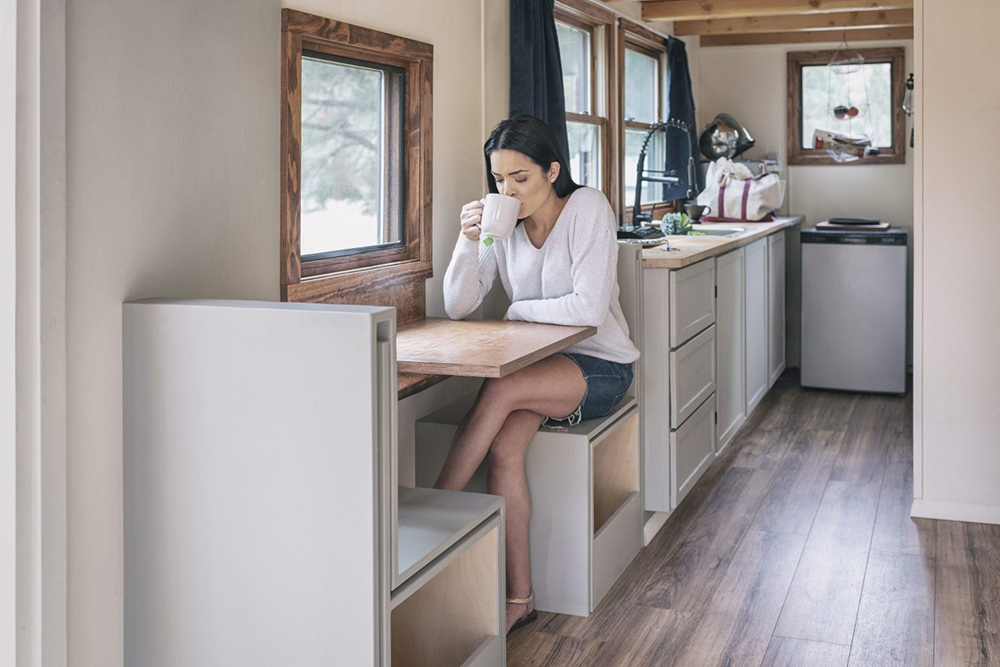
也許你聽(tīng)說(shuō)過(guò)“通貨緊縮”,,或是在打開(kāi)一袋薯片時(shí)經(jīng)歷過(guò)這樣的情境。那么,,正如《財(cái)富》雜志之前報(bào)道的那樣,,“通貨緊縮”正在襲擊住宅領(lǐng)域。房屋面積在縮小,,價(jià)格卻在飆升,。據(jù)服務(wù)性新聞集團(tuán)USA Today Homefront最近的一項(xiàng)分析,與五年前相比,,美國(guó)住宅的面積中位數(shù)縮小了128平方英尺(約合11.89平方米),,價(jià)格卻上漲了125000美元。
該公司的研究團(tuán)隊(duì)利用Realtor.com網(wǎng)站的數(shù)據(jù),,研究了150個(gè)人口最多的大都會(huì)區(qū)的房屋掛牌價(jià)格和面積變化情況,。在這些地區(qū)中,只有18個(gè)地區(qū)的房屋面積在過(guò)去五年中有所擴(kuò)大,。但無(wú)一例外,,它們的價(jià)格都出現(xiàn)了上漲?;旧?,現(xiàn)在的房屋面積中位數(shù)縮水了6%以上,而房?jī)r(jià)中位數(shù)總體上漲了39%,,每平方英尺的房?jī)r(jià)上漲了52%,。
分析稱:“大都市房屋面積不斷縮小,每平方英尺的價(jià)格繼續(xù)上漲,。從本質(zhì)上講,,建造更小戶型的房屋并不能阻止每平方英尺價(jià)格的上漲,這使得購(gòu)房者只能買到更小戶型的房子,,卻要承擔(dān)更高的房貸,。”
然而,,分析指出,,“這種現(xiàn)象的普遍程度在各大都會(huì)地區(qū)有所不同”,就像房地產(chǎn)界的所有情況一樣,??屏_拉多斯普林斯的房屋縮水幅度最大,自2019年以來(lái)縮水了21%,而掛牌價(jià)格上漲了25%,。更不必提及,,在房屋縮水的10個(gè)大都會(huì)區(qū)中,有7個(gè)位于南部,,僅北卡羅來(lái)納州就有4個(gè),。另一方面,在達(dá)文波特大都會(huì)區(qū)(也稱闊德城),,房屋面積增加了約11%,,房?jī)r(jià)上漲了58%。就每平方英尺的價(jià)格而言,,那不勒斯大都會(huì)區(qū)的漲幅最大,,接近88%,這可能是佛羅里達(dá)州泡沫的另一個(gè)跡象,。
以下是我們了解到的情況:超低的抵押貸款利率,,加上在任何地方工作的能力,再加上對(duì)空間的需求,,在疫情期間推動(dòng)了房地產(chǎn)熱潮,。房?jī)r(jià)暴漲,而當(dāng)這一切結(jié)束時(shí),,由于美聯(lián)儲(chǔ)提高利率以為通脹降溫,,抵押貸款利率也隨之飆升。我們面臨高房?jī)r(jià)和高抵押貸款利率?,F(xiàn)在兩者都略有改善:抵押貸款利率下降,,房?jī)r(jià)上漲放緩。但是,,人們的負(fù)擔(dān)能力仍然有所不足,。我們不能忘記:土地成本和建筑成本也在上漲,。
大約一年前,,《財(cái)富》雜志報(bào)道說(shuō),建筑商別無(wú)選擇,,只能建造更小戶型的住宅——這是他們應(yīng)對(duì)負(fù)擔(dān)能力日益惡化的辦法,。房屋建筑數(shù)據(jù)公司Zonda的阿里·沃爾夫(Ali Wolf)當(dāng)時(shí)解釋說(shuō):“建筑商越來(lái)越意識(shí)到如今的負(fù)擔(dān)能力面臨著多么嚴(yán)峻的挑戰(zhàn),他們需要采取措施才能繼續(xù)取得成功,。在這種情況下,,他們正試圖降低房屋的整體面積,以幫助降低整體房?jī)r(jià),?!?/p>
早在此之前,約翰·伯恩斯研究咨詢公司(John Burns Research and Consulting)的馬特·桑德斯就告訴《財(cái)富》雜志:“建筑商們確實(shí)在積極應(yīng)對(duì)負(fù)擔(dān)能力問(wèn)題,,他們采取的主要手段之一就是減少房屋面積,?!?/p>
不過(guò),兩人都表示,,房屋實(shí)際上并沒(méi)有變成微型版本,。相反,建筑商們正在尋找可以削減的死角,,或者在住宅內(nèi)部進(jìn)行取舍,。比方說(shuō),他們建造了更多的戶外空間,,而不是額外的臥室,。即便如此,隨著房屋面積的縮小,,房?jī)r(jià)仍在上漲,,但漲幅不如建筑商什么手段都不采取的情況下那么大。無(wú)論如何,,這種情況短期內(nèi)都不太可能改變,。(財(cái)富中文網(wǎng))
譯者:中慧言-王芳
也許你聽(tīng)說(shuō)過(guò)“通貨緊縮”,或是在打開(kāi)一袋薯片時(shí)經(jīng)歷過(guò)這樣的情境,。那么,,正如《財(cái)富》雜志之前報(bào)道的那樣,“通貨緊縮”正在襲擊住宅領(lǐng)域,。房屋面積在縮小,,價(jià)格卻在飆升。據(jù)服務(wù)性新聞集團(tuán)USA Today Homefront最近的一項(xiàng)分析,,與五年前相比,,美國(guó)住宅的面積中位數(shù)縮小了128平方英尺(約合11.89平方米),價(jià)格卻上漲了125000美元,。
該公司的研究團(tuán)隊(duì)利用Realtor.com網(wǎng)站的數(shù)據(jù),,研究了150個(gè)人口最多的大都會(huì)區(qū)的房屋掛牌價(jià)格和面積變化情況。在這些地區(qū)中,,只有18個(gè)地區(qū)的房屋面積在過(guò)去五年中有所擴(kuò)大,。但無(wú)一例外,它們的價(jià)格都出現(xiàn)了上漲,?;旧希F(xiàn)在的房屋面積中位數(shù)縮水了6%以上,,而房?jī)r(jià)中位數(shù)總體上漲了39%,,每平方英尺的房?jī)r(jià)上漲了52%。
分析稱:"大都市房屋面積不斷縮小,每平方英尺的價(jià)格繼續(xù)上漲,。從本質(zhì)上講,,建造更小戶型的房屋并不能阻止每平方英尺價(jià)格的上漲,這使得購(gòu)房者只能買到更小戶型的房子,,卻要承擔(dān)更高的房貸,。"
然而,分析指出,,“這種現(xiàn)象的普遍程度在各大都會(huì)地區(qū)有所不同”,,就像房地產(chǎn)界的所有情況一樣??屏_拉多斯普林斯的房屋縮水幅度最大,,自2019年以來(lái)縮水了21%,而掛牌價(jià)格上漲了25%,。更不必提及,,在房屋縮水的10個(gè)大都會(huì)區(qū)中,有7個(gè)位于南部,,僅北卡羅來(lái)納州就有4個(gè),。另一方面,在達(dá)文波特大都會(huì)區(qū)(也稱闊德城),,房屋面積增加了約11%,,房?jī)r(jià)上漲了58%。就每平方英尺的價(jià)格而言,,那不勒斯大都會(huì)區(qū)的漲幅最大,,接近88%,這可能是佛羅里達(dá)州泡沫的另一個(gè)跡象,。
以下是我們了解到的情況:超低的抵押貸款利率,,加上在任何地方工作的能力,再加上對(duì)空間的需求,,在疫情期間推動(dòng)了房地產(chǎn)熱潮,。房?jī)r(jià)暴漲,而當(dāng)這一切結(jié)束時(shí),,由于美聯(lián)儲(chǔ)提高利率以為通脹降溫,,抵押貸款利率也隨之飆升。我們面臨高房?jī)r(jià)和高抵押貸款利率?,F(xiàn)在兩者都略有改善:抵押貸款利率下降,房?jī)r(jià)上漲放緩,。但是,,人們的負(fù)擔(dān)能力仍然有所不足。我們不能忘記:土地成本和建筑成本也在上漲。
大約一年前,,《財(cái)富》雜志報(bào)道說(shuō),,建筑商別無(wú)選擇,只能建造更小戶型的住宅——這是他們應(yīng)對(duì)負(fù)擔(dān)能力日益惡化的辦法,。房屋建筑數(shù)據(jù)公司Zonda的阿里·沃爾夫(Ali Wolf)當(dāng)時(shí)解釋說(shuō):“建筑商越來(lái)越意識(shí)到如今的負(fù)擔(dān)能力面臨著多么嚴(yán)峻的挑戰(zhàn),,他們需要采取措施才能繼續(xù)取得成功。在這種情況下,,他們正試圖降低房屋的整體面積,,以幫助降低整體房?jī)r(jià)?!?/p>
早在此之前,,約翰·伯恩斯研究咨詢公司(John Burns Research and Consulting)的馬特·桑德斯就告訴《財(cái)富》雜志:“建筑商們確實(shí)在積極應(yīng)對(duì)負(fù)擔(dān)能力問(wèn)題,他們采取的主要手段之一就是減少房屋面積,?!?/p>
不過(guò),兩人都表示,,房屋實(shí)際上并沒(méi)有變成微型版本,。相反,建筑商們正在尋找可以削減的死角,,或者在住宅內(nèi)部進(jìn)行取舍,。比方說(shuō),他們建造了更多的戶外空間,,而不是額外的臥室,。即便如此,隨著房屋面積的縮小,,房?jī)r(jià)仍在上漲,,但漲幅不如建筑商什么手段都不采取的情況下那么大。無(wú)論如何,,這種情況短期內(nèi)都不太可能改變,。(財(cái)富中文網(wǎng))
譯者:中慧言-王芳
Maybe you’ve heard of shrinkflation or lived it while opening a bag of chips. Well, it’s coming for your house, as Fortune has previously reported. Homes are shrinking in size and soaring in price. The median American home is 128 square feet smaller and $125,000 more expensive than it was five years ago, according to a recent analysis from service journalism group USA Today Homefront.
Its research team used Realtor.com data to examine changes in listing prices and square footage across 150 of the most populous metropolitan areas. Among those areas, only 18 have seen home sizes expand during the past five years. But without fail, each one saw prices rise. Basically, the median home is more than 6% smaller now, while the median price is 39% more expensive overall—and 52% more expensive per square foot.
“Metros with shrinking square footage continue to get more expensive per square foot,” the analysis said. “Essentially, building smaller houses isn’t stopping the growth in price per square foot, leaving buyers with a smaller house and an inflated mortgage.”
However, “the phenomenon’s prevalence varies across metro areas,” the analysis states—like everything in the housing world. Homes in Colorado Springs shrunk the most, by 21% since 2019, while listing prices rose 25%. Not to mention, seven of the 10 metros where homes contracted are in the South, four in North Carolina alone. On the other hand, in the Davenport metropolitan area, also known as Quad Cities, home sizes increased around 11%, and home prices leapt 58%. And in terms of price per square foot, it rose the most in the Naples metropolitan area, by almost 88%, potentially another sign of the bubble in Florida.
So here’s what we know: Ultralow mortgage rates coupled with the ability to work from wherever, plus a need for space, fueled a housing boom throughout the pandemic. Home prices skyrocketed, and when it was over, because the Federal Reserve raised interest rates to lower hot inflation, mortgage rates soared. We were left with high home prices and high mortgage rates. Both have improved slightly: Mortgage rates are lower and home price inflation is slowing. Still, affordability is shot. And let’s not forget the cost of land and the cost to build have gone up too.
About a year ago, Fortune reported that builders had no choice but to build smaller homes—it was their answer to deteriorated affordability. “Builders have become increasingly aware of how bad affordability challenges are today, and that they need to do something to continue to be successful,” Ali Wolf of home construction data firm Zonda explained at the time. “And in this case, they’re trying to lower the overall home size to help lower the overall home price.”
Even before that, John Burns Research and Consulting’s Matt Saunders told Fortune: “There’s really this active response by the builders to address these affordability concerns head-on, and one of the main kind of levers that they’re pulling is reducing home square footage.”
Still, both suggested homes weren’t actually becoming miniature versions of themselves. Instead, builders were looking for dead space to cut or making trade-offs within the homes. Let’s say they built more outdoor space rather than extra bedrooms. Even so, with smaller home sizes, prices have still gone up, but not as much as they would have if builders did nothing at all. Either way, it doesn’t seem likely to change anytime soon.






